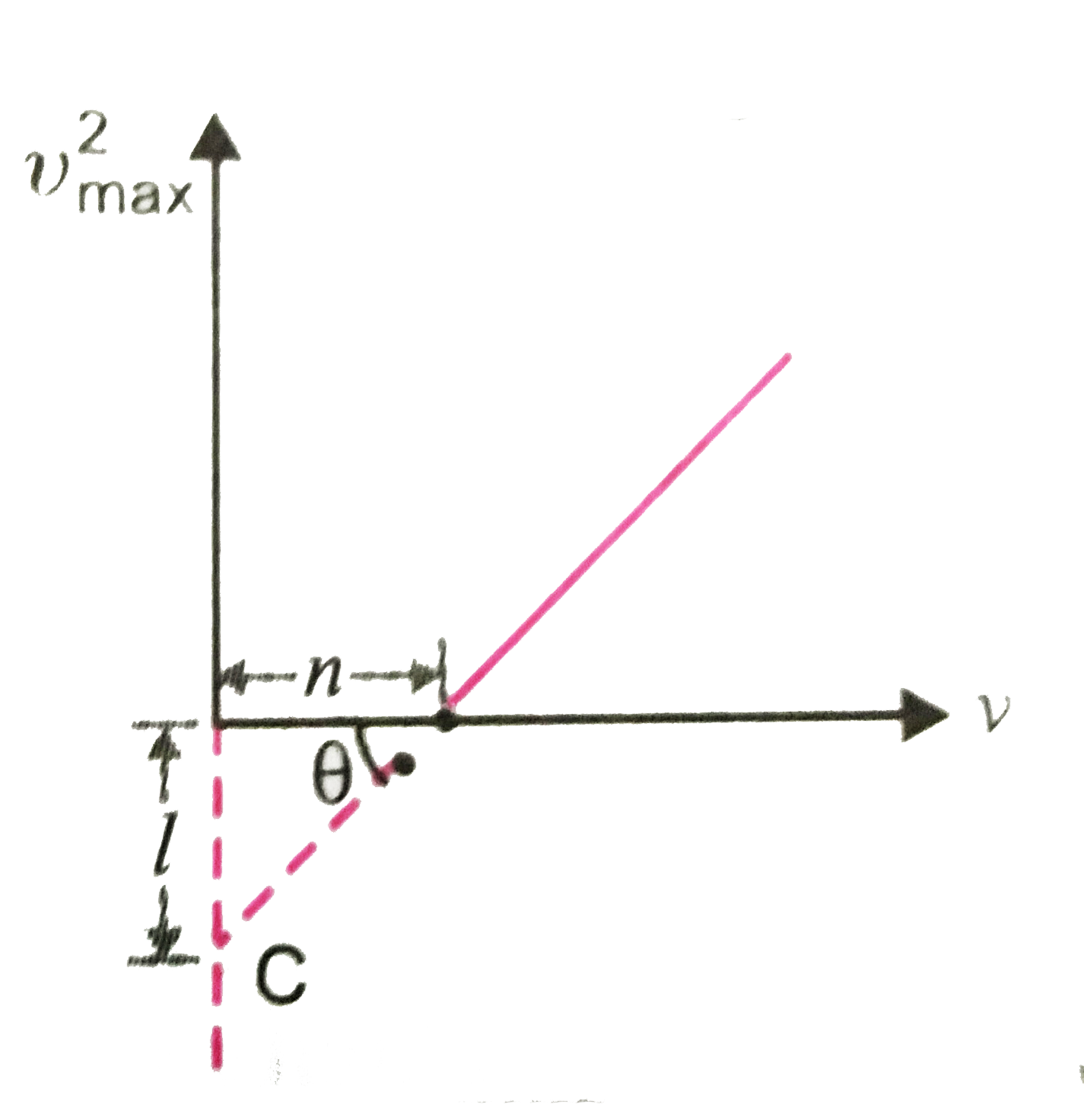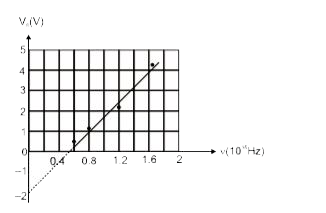When a given photosensitive material is irradiated with light of frequency ν, and maximum speed of the emitted photoelectrons equals vmax. The square of vmaxis observed to very with v, as per the graph shown in fig. Obtain expression for (i) Planck's constant and (ii) the work function of the given photosensitive material, in terms of the parameter l, n and the mass m of the electrons.

(a) By Einstein.s photoelectric equation we have
Kmax=12mv2max=hv−ϕ0
or v2max=(2hm)v−2ϕ0m
Slope of the graph =2hm=ln
(b) The intercept on v2max axis is 2ϕ0m=l
Therefore , work function ϕ0=ml2
(c) Threshold frequency is the intercept on v axis i.e.
Topper's Solved these Questions
- DUAL NATURE OF RADIATION AND MATTER BOOK - MODERN PUBLICATIONCHAPTER - DUAL NATURE OF RADIATION AND MATTER EXERCISE - Revision Exercises (Long Answer Questions)
3 Videos
- DUAL NATURE OF RADIATION AND MATTER BOOK - MODERN PUBLICATIONCHAPTER - DUAL NATURE OF RADIATION AND MATTER EXERCISE - Revision Exercises (Numerical Problems)
20 Videos
- DUAL NATURE OF RADIATION AND MATTER BOOK - MODERN PUBLICATIONCHAPTER - DUAL NATURE OF RADIATION AND MATTER EXERCISE - Revision Exercises (Fill in the Blanks)
11 Videos
- CURRENT ELECTRICITYBOOK - MODERN PUBLICATIONCHAPTER - CURRENT ELECTRICITYEXERCISE - Chapter Practice Test
15 Videos
- ELECTRIC CHARGES AND FIELDS BOOK - MODERN PUBLICATIONCHAPTER - ELECTRIC CHARGES AND FIELDS EXERCISE - Chapter Practice Test
15 Videos
Similar Questions
When a given photosenstive material is irradiated with light of frequency v, and maximum speed of the emitted photoelectrons equals vmax. The square of vmaxis observed to very with v, as per the graph shown in fig. Obtain expression for (i) Planck's constant and (ii) the work function of the given photosenstive material, in terms of the parameter l, n and the mass m of the electrons.

View SolutionGiven in fig. is the graph between frequency v of the incident light and maximum kinetiec energy (Ek) of the emitted photoelectrons. Find the values of (i) threshold frequency and (ii) work function form the graph.

View Solution
Knowledge Check
In the photoelectric effect the eletrons are emiited intantaneously from a given matal plate when it is irradiated with radiation of frequency equal to or greater then some minimum ferquency, is called the threshold frequency.According to Planck's idea, light may be considered to be made up discrete particles called photons.Each photon carries energy equal ti hv.When this photon cllides with the electron of the metal, the electron acquires energy of the emitted electron is given by :
hv=K.Emaximum+PE=12mu2+PE
If the incident rediation is of threshold frequency the electron will be emitted without any kinetic energy
i.e hv0
∴12mu2=hv−hv0
A plot of kinetic energy of the emitted electron versus frequency of the incident radiation yields a straight line given as :

The number of photoelectrons emitted depends upon :AThe intensity of the incident radiationBThe frequency of incident radiationCthe product if intensity and frequency of incident radiationDNone of the aboveIn the photoelectric effect the eletrons are emiited intantaneously from a given matal plate when it is irradiated with radiation of frequency equal to or greater then some minimum ferquency, is called the threshold frequency.According to Planck's idea, light may be considered to be made up discrete particles called photons.Each photon carries energy equal ti hv.When this photon cllides with the electron of the metal, the electron acquires energy of the emitted electron is given by :
hv=K.Emaximum+PE=12mu2+PE
If the incident rediation is of threshold frequency the electron will be emitted without any kinetic energy
i.e hv0
∴12mu2=hv−hv0
A plot of kinetic energy of the emitted electron versus frequency of the incident radiation yields a straight line given as :

A beam of white light is dispersed into its wavelenght components of potassium metal. What of the electron emitted by the different light component ?ABlue gtgreen gt orange gt yellowBViolet gt blue gt orange gt redCyellow gt green gt blue gt voiletDOrange gt yellow gt blue gt voiletIn a photocell circuit the stopping potential, V0, is a measure of the maximum kinetic energy of the photoelectrons. The following graph shows experimentally measured values of stopping potential versus frequency v of incident light.

The values of Planks constant and the work function as determined from the graph are (taking the magnitude of electronic charge to be e=1.6×10−19C)A6.4×10−34Js,2.0eVB6.0×10−34Js,2.0eVC6.4×10−34Js,3.2eVD6.0×10−34Js,3.2eV
(a) Photoelectric threshold of metallic silver is λ=3800Å. Ultravilolet light of λ=260 nm is incident on silver surface. Calculate :
(i) the value of work function in joule and eV
Kmax of the emitted photoelectrons
(iii) vmax of the photoelectrons
(b) Ultraviolet light of wavelength 280 nm is used in an experiment on photoelectric effict with lithium (ϕ=2.5eV) cathode. Find
(i) the maximum kinetic energy of the photoelectrons
(ii) the stopping potential
(c) Find the maximum magnitude of the linear momentum of a photelectron emitted when light of wavelength 400 nm falls on a metal (ϕ=2.5eV).
(d) A monochromitc light source of intensity 5 mW emits 8×105 photons per second. This light ejects photoelectrons from a metal surface. The stopping potential for this set up is 2.0V . Calculate the work function of the metal.
(e) The maximum kinetic energy of photoelectrons emitted from a certain metallic surface is 30 eV when imonochromatic radiation of wavelength λ falls on it. When the same surface is illuminated with light of wavelength 2λ the maximum kinetic energy of photo electrons is observed to be 10 eV. Calculate the wavelength λ and determine the maximum wavelength of incident radiation for which photoelectrons can be emitted by this surface.
View SolutionIn an experiment on photoelectic effect, the graph between maximum kinetic energy (Kmax) and frequency of emitted photoelectron from metal surface is found to be a straight line as shown in fig. Calculate

(a) thereshold frequency.
(b) work function of metal in electron volt.
(c) Planck's constant and
maximum kinetic energy of the emitted electron by light of frequency v=8×1014s−1.
View SolutionIn the photoelectric effect the eletrons are emiited intantaneously from a given matal plate when it is irradiated with radiation of frequency equal to or greater then some minimum ferquency, is called the threshold frequency.According to Planck's idea, light may be considered to be made up discrete particles called photons.Each photon carries energy equal ti hv.When this photon cllides with the electron of the metal, the electron acquires energy of the emitted electron is given by :
hv=K.Emaximum+PE=12mu2+PE
If the incident rediation is of threshold frequency the electron will be emitted without any kinetic energy
i.e hv0
∴12mu2=hv−hv0
A plot of kinetic energy of the emitted electron versus frequency of the incident radiation yields a straight line given as :

A laser producting monochromatic lights of different wavelenght is uesd to eject electrons from the sheet of glod having threshold frequency 6.15×1014s−1 Which of the following incident rediation will be suitable for the ejecting of electrons ?
View SolutionThreshold frequency for photosensitive material is v0. If photons of frequency 2v0 fall on this surface, the electrons come out with a maximum speed of 4×106ms−1. When photons of frequency 5v0 fall on the same surface, the maximum speed of the ejected electrons will be
View SolutionGraph of stopping potential for most energetic emitted photoelectron (VS) with frequency of incident radiation on metal is given below.

The value of ABBC, in graph is
(h=Planck's constant, e = electronic charge)
View Solution
